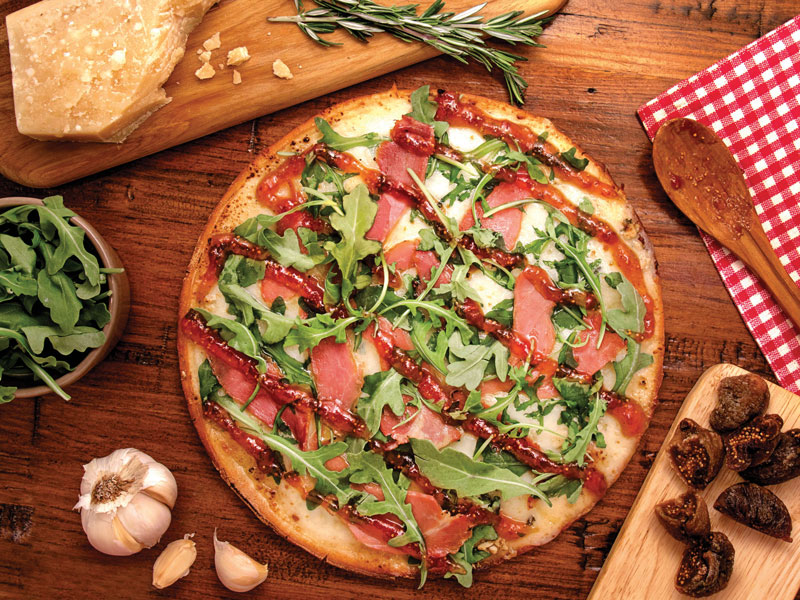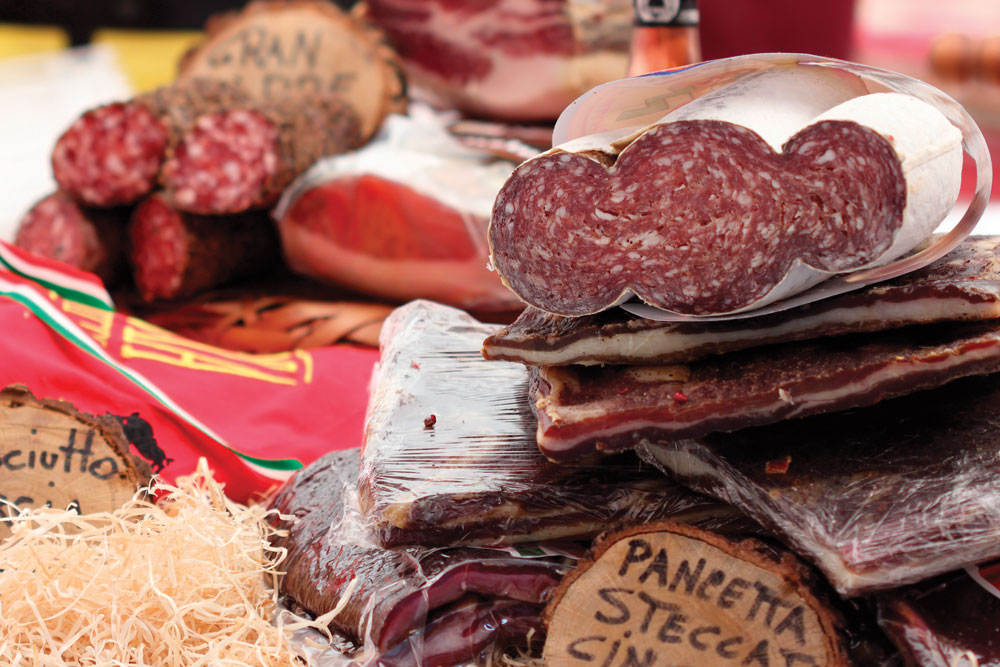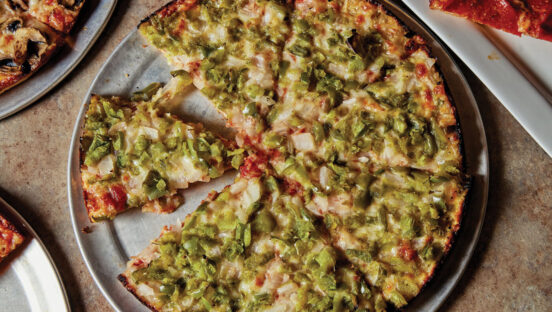You already know that pepperoni has been America’s favorite pizza topping for decades—but times are changing, and so are consumer tastes. When was the last time you introduced your guests to something different, such as an imported Italian salami or a beautiful prosciutto di Parma? Maybe it’s time to expand your horizons, explore the full range of Italian meats and discover how you can pair them with nearly everything on your existing menu.
“We use all kinds of meat, from raw to cured to dry-aged to dehydrated,” says Fabio Viviani, celebrity chef and owner of a growing list of restaurants in Chicago, including Siena Tavern and Bar Siena. “The most common meats we use for our pizzas are cold cuts and housemade sausages. We do a lot of salami, coppa, prosciutto sausage and housemade pepperoni. We chose these because they cook in the oven very well. Prosciutto di Parma and prosciutto di San Daniele are the best options when you want to slice the meat very thinly and place it on the pizza after cooking; everything else cooks and crisps very well.”
As for the rest of the menu beyond pizza, Viviani say you can pair Italian meats with almost everything. “Put them together with sharp cheeses, any kind of vegetable, mozzarella, truffles, mushrooms, Brussels sprouts, figs or pickled vegetables—really anything but fish,” he says.
Anthony Russo’s list may be slightly shorter, but the founder/CEO and head chef of Houston-based Russo’s restaurants also takes full advantage of cold cuts. “The main three Italian meats I use are soppressata salami, prosciutto di Parma and mortadella ham,” he says.
Good choices, all of them. So let’s take a closer look at each one.

The Prosciutto Puzzle |
| Confused by prosciutto? Celebrity chef and restaurateur Fabio Viviani explains the salty Italian cured meat:
“There’s a lot of confusion about prosciutto and ham in America. When you say ‘prosciutto,’ it’s not prosciutto ham. Ham is the English translation for prosciutto, but the culinary meaning is completely different. A piece of ham is a piece of boiled pork meat, which doesn’t always come from a whole leg. Ham is cooked and boiled, sometimes smoked. Prosciutto is hung and cured with salt from a raw stage. When we discuss prosciutto, I always suggest getting either prosciutto di Parma or prosciutto di San Daniele. Although you can find good local, domestic, salt-cured prosciutto, I still stick with the traditional, because I feel they offer the best quality. You pay for it, but you always know what you’re getting. The domestic prosciutto isn’t as well-regulated as it is in Italy; if you get a younger one, it can be meaty and gamey, and if you get one that’s too old, it can be dry and rubbery.” Above: Prosciutto di Parma is one of Chef Anthony Russo’s favorite Italian cold cuts for pizza toppings, along with soppressata and mortadella. |
Prosciutto di Parma
A first choice for many chefs is prosciutto di Parma, thanks to its salty flavor and versatility. “I use prosciutto di Parma on pizza, salads, pasta and sandwiches, because it slices really thin and is very soft,” Russo says. “I also wrap it around fresh buffalo mozzarella and grill it with a little olive oil for a great appetizer.”
One of the favorites at Russo’s is a flatbread sandwich with fresh mozzarella, prosciutto di Parma, arugula and pesto. “You can tell if a prosciutto is from Parma because it has a nice red color and it’s nice and soft, not chewy like some of the domestic prosciuttos can be,” Russo notes. (Learn more about prosciutto in the sidebar, “The Prosciutto Puzzle,” on this page.)
Soppressata Salami and Dry Italian Sausage
Much like prosciutto, salami and Italian sausage can be a great addition to the menu if you’re looking for something that’s easy to pair with many diverse dishes. “Dry Italian sausage and salami are very versatile,” Viviani says. “We use salami for salad, pizza, pasta, vinaigrette and more. Salami—whether dry or wet—is a very user-friendly, headache-free kind of cold cut that is delicious by itself or paired with a lot of things.”
For a little kick, try a spicy soppressata and see how your customers react. After all, today’s consumers are more attracted to dishes with a kick. “I don’t want to buy the regular salami that you can get anywhere else, so I use soppressata for my sandwiches,” Russo says. “Soppressata is a little spicy and really good.”
Mortadella
Mortadella, an Italian pork sausage flavored with various spices, plays a featured role on artisanal pizzas made by famed chefs such as Giada de Laurentiis, Marc Vetri and Emeril Lagasse. “There’s a lot of different types of mortadella ham, some with pistachio in it, some without,” Russo says. “I like the imported mortadella with pistachios from Italy. You can really taste the flavors in the imported one.”
Choose Quality Over Price
When adding any new menu item, price is always a concern. But when it comes to high-end ingredients such as imported Italian meats, consider the benefits of choosing quality over price. A little goes a long way when the bold flavors of a spicy soppressata or salty prosciutto di Parma are paired with a gorgeous, fresh salad or housemade cheese.
“As a chef, I do look at the price, but what sells me is the quality,” Russo says. “The quality will set us apart from other pizza chains, and customers nowadays know the difference. We encourage our servers to promote the fact that we’re serving quality imported ingredients as well. When you look at it as $9 a pound versus $14 a pound and break it down by ounces, it’s a difference of pennies.”
“Start with a good salami, a good prosciutto and a good pepperoni,” Viviani agrees. “Everyone knows them, they’re easy to source, and if you want to make your own, salami and pepperoni are easy to make.”
 |
|
Price is important but so is quality. Using better meats, including pepperoni, prosciutto and salami, will set your pizzeria apart from the big chains. Photo provided by Siena Tavern. |
|
Mind Your Meats |
| Need a quick refresher course in Italian meats? Here’s a rundown of some of the most popular types.
Capicola and Coppa: These are very similar dry-cured meats that hail from different regions of Italy and are taken from the neck muscle of a pig. Sometimes sweet and sometimes spicy, they’re versatile and great with anything from salads to cheese plates to sandwiches. Lardo: Similar to salt pork, this is great on pizza or bruschetta. Lardo is taken from the fatback of a pig and is cured with herbs and spices. Mortadella: Ground pork is mixed with lardon, pepper and often pistachios to make this popular Italian sandwich meat. Some call it Italy’s version of bologna. Pancetta: Like bacon, but cured and not smoked, pancetta is taken from pork belly, seasoned with salt and pepper, and hung to cure within a casing. Unlike prosciutto, which is often served uncooked, pancetta requires cooking. It’s great cubed and served over salads, pastas and in soups. Prosciutto: Taken from the hind leg of a pig (sometimes boar), prosciutto is dry-cured and can be served cooked (cotto) or uncooked (crudo). Due to its traditional Italian flavor, many restaurateurs recommend prosciutto di Parma for use on meat and cheese plates and as a pizza topping. Prosciutto di San Daniele is another favorite that’s a little sweeter and darker in color. Sopressata: Made from pork that’s ground into sausage, the flavor of this dry-cured meat—hot or not—depends on where it originated in Italy. |
Not So Foreign Anymore
If you’re worried that your customers won’t understand what mortadella or soppressata is, fear not. Russo, who owns restaurant locations in places such as Texas, Florida, Oklahoma and Tennessee, says that customers are ingredient-savvy nowadays. “Ten years ago, not too many people used prosciutto on their pizza,” he says. “Now prosciutto is more of a foodie dish. Mortadella may not be as popular, but we serve it on our sandwiches, and customers really enjoy it.”
Russo believes that today’s customers get a little bored with the same old pepperoni and sausage. “They want something unique and different. You can do a lot with prosciutto and pancetta on a pizza—add arugula, kale or artichoke hearts. You can also use Italian meats for calzones, pasta, bruschetta and antipasto salads, or create an Italian meat tray with prosciutto, mortadella, and Genoa salami.”
No matter how you decide to experiment with adding new cuts of Italian meats to your topping lineup, start small and test the waters. Focus on quality over quantity and let your sales forge a path toward increased creativity.















